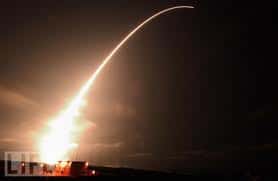
 Hubble Telescope Captures First Images of
Hubble Telescope Captures First Images of
Aftermath from Possible Asteroid Collision
NASA’s Hubble Space Telescope has captured the first snapshots of a suspected collision of two asteroids in space. The images show a bizarre X-shaped object trailing a comet-like trail of material.
In January 2010, astronomers began using Hubble to track the object for five months. They thought they had witnessed a fresh asteroid collision, but were surprised to learn the collision occurred in early 2009.
“We expected the debris field to expand dramatically, like shrapnel flying from a hand grenade,” said astronomer David Jewitt of the University of California in Los Angeles, who is a leader of the Hubble observations. “But what happened was quite the opposite. We found that the object is expanding very, very slowly.”
The peculiar object, dubbed P/2010 A2, was found cruising around the asteroid belt, which is a reservoir of millions of rocky bodies between the orbits of Mars and Jupiter. It is estimated that modest-sized asteroids smash into each other about once a year. When the objects collide, they inject dust into interplanetary space. But until now, astronomers have had to rely on models to make predictions about the frequency of these collisions and the amount of dust produced.
Catching colliding asteroids is difficult because large impacts are rare while small ones, such as the one that produced P/2010 A2, are exceedingly faint. The two asteroids that make up P/2010 A2 were unknown before the collision because they were too faint to be noticed. The collision itself was unobservable because of the asteroids’ position in relation to the Sun.
“These observations are important because we need to know where the dust in the solar system comes from, and how much of it comes from colliding asteroids as opposed to ‘outgassing’ comets,” Jewitt said. “We also can apply this knowledge to the dusty debris disks around other stars, because these are thought to be produced by collisions between unseen bodies in the disks. Knowing how the dust was produced will yield clues about those invisible bodies.”
The Hubble images, taken from January to May 2010 with the telescope’s Wide Field Camera 3, reveal a point-like object about 400 feet wide, with a long, flowing dust tail behind a never-before-seen X pattern. Particle sizes in the tail are estimated to vary from about 1/25th of an inch to an inch in diameter.
The 400-foot-wide object in the Hubble image is the remnant of a slightly larger precursor body. Astronomers think a smaller rock, perhaps 10- to 15 feet wide, slammed into the larger one. The pair probably collided at high speed, about 11,000 mph, which smashed and vaporized the small asteroid and stripped material from the larger one. Jewitt estimates that the violent encounter happened in February or March 2009 and was as powerful as the detonation of a small atomic bomb.
Sunlight radiation then swept the debris behind the remnant asteroid, forming a comet-like tail. The tail contains enough dust to make a ball 65 feet wide, most of it blown out of the bigger body by the impact-caused explosion. The science journal Nature published the findings in its Oct. 14 issue.
For images, movies, and more information:
http://hubblesite.org/news/2010/34
http://www.nasa.gov/hubble
You can contact Bob Eklund at [email protected], or visit his website at www.bobeklund.com.





Be the first to comment